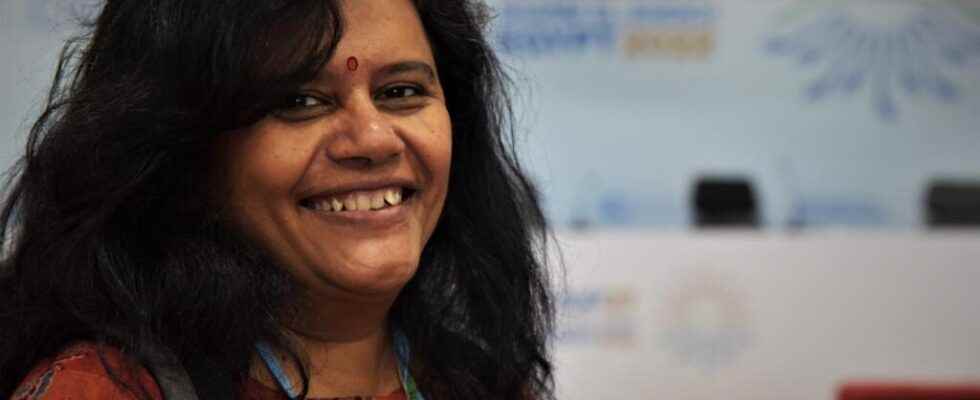Thanks to this tool, nearly 125,000 people have permanent access to rainwater. And Bhungroo is above all a matter of women, who are the only ones trained to use it. Meeting with her co-inventor Trupti Jain, who came to the COP from her native Gujarat.
From our special correspondent in Sharm el-Sheikh
Creating an artificial water table to evacuate the overflow of monsoon water and store it in the basement in anticipation of dry periods, it was necessary to think about it. Biplab Ketan Paul and Trupti Jain are not engineers for a rupee, but they realized it, in 2007, in a field located 120 km from Ahmedabad, the big city of Gujarat, in the North-West of India.
“ The climate is semi-arid and the Kutch desert advances “, explains Trupti Jain, 52 years old. The vegetation that served as a barrier to the sea salt carried by the winds has disappeared. This is deposited on the ground and prevents water from seeping into the ground. Added to this is a disturbed monsoon, she noted: ” it rains a lot over a shorter period. The water drowns the crops, making them unusable. Three problems in one: during the monsoon, stagnant water prevents agricultural activities; during winter and summer there is none in the basement. People have no choice but to migrate to work in construction in the large neighboring megalopolis of Ahmedabad.
A pipe to store the overflow
Urged by the women farmers of the village, Trupti Jain and Biplab Ketan Paul, supported by various institutions, imagine Bhungroo, straw in the Gujarati language. The system is quite simple: a pipe is inserted into the ground, in the middle of the flooded area, and crosses a first layer of rock. Then, according to the geological studies carried out beforehand, it reaches a softer layer, composed of earth and sand. About 12 and 18 meters deep. At this level, the pipe is perforated. On land, the overflow of water is injected into the pipe and can be stored in the soft zone. A water table is thus reconstituted, which can go up to ” 40 million liters in the case of a site located near Bombay, specifies Trupti Jain. Inside the tube is inserted another pipe: the pump, equipped with a filter to suck up only the water and leave the solid at the “ Mother Earth she says poetically.
Each year in India, 12 million hectares of land are affected or lost by desertification. And five million smallholders are affected by salinizationdroughts and floods.
The appearance of Bhungroo brings with it a string of benefits. The first of these is the reduction of the salinity of the land to be cultivated. The salt passes into the water table and is diluted there. Performance suffers. The availability of water and its decongestion has multiplied production: ” From zero harvest some years, we went to at least two if not three “says Trupti Jain. One harvest for food, one for sale, one last to feed the animals: the standard of living of the communities has greatly improved, she says. The benefits reaped are not only food. They allow communities to stabilize: no more need to migrate to cities; an income that allows small landowners to get out of debt and buy back their plots; the education of children is strengthened, as is the health of populations.
But it is the women who benefit above all from this innovation. ” Women farmers were the first interlocutors of Biplab Ketan Paul. They came to see him in the 1990s to ask him to find a solution to this congestion problem. In 2001, an earthquake ravaged the village and prompted them to act. “ In 2007, they were given the right to use Bhungroo. Women are not the owners of the land, but now they are the only owners of an essential part of everyday life: the use of water. And social acceptance hasn’t been a problem, according to Trupti Jain: ” There was no water, no harvest, no money. The men quickly understood that it was win-win. Now holders of technical skills, women are also more supportive, especially when a husband is reluctant to this emancipation. “ Social pressure works. Solidarity between women has therefore brought down domestic violence. »
A technology that is beginning to be exported
Each Bhungroo irrigates between 8 and 10 hectares, benefits a handful of farmers and costs around 750 euros. Naireeta Services, the social enterprise of Trupti Jain and Biplab Ketan Paul, operates on generated revenue and grants. It assists communities that cannot equip themselves. The system has spread to Vietnam, Bangladesh, Ghana and Rwanda. 4,600 units are deployed in total to around 125,000 people. The two entrepreneurs are eyeing other countries in Africa and Southeast Asia.
Trupti Jain recognizes two limits to invention: First, you can’t install it everywhere. In mountain landscapes for example, it is feasible, but more complicated. The other obstacle is cultural when it comes to setting up the tool in a foreign country. ” VSIt’s not easy to find the right partner who has good relations with the women, with the community. »
This tool has global development potential, believes Trupti Jain, who does not want to stop there: ” my dream is to be able to supply Bhungroos to millions of farmers. But scaling up won’t be easy ! »
For this invention, surprisingly simple compared to the service rendered, Trupti received several awards, including in 2018 that of the Constitution of Women and Gender, which is one of the nine actors recognized in the COPs. About twenty laureates from were invited to Sharm el-Sheikh.
► Read also: COP26: women, victims and solution of climate change
